(AKA: Empire Mill, Williford Mill, Milner Mill, Jones Mill and Amelia Mill)
By Joe F. Head
Formerly located southwest of Emerson, Georgia on Pumpkinvine Creek, is a forgotten grist mill that has eluded local historians for decades regarding its precise location and further confused by the use of multiple names. Additionally, its identity has suffered misperceived names with other mills in the area such as Moore’s or Wofford’s Mill. Often the mill would be commonly known for the owner rather than a given name on a bill of sale or deed. While likely not comprehensive, the following article is an attempt to capture the storied mill history and its ownership saga with a dash of a personal journal kept by a young girl who lived at the mill during its final years.
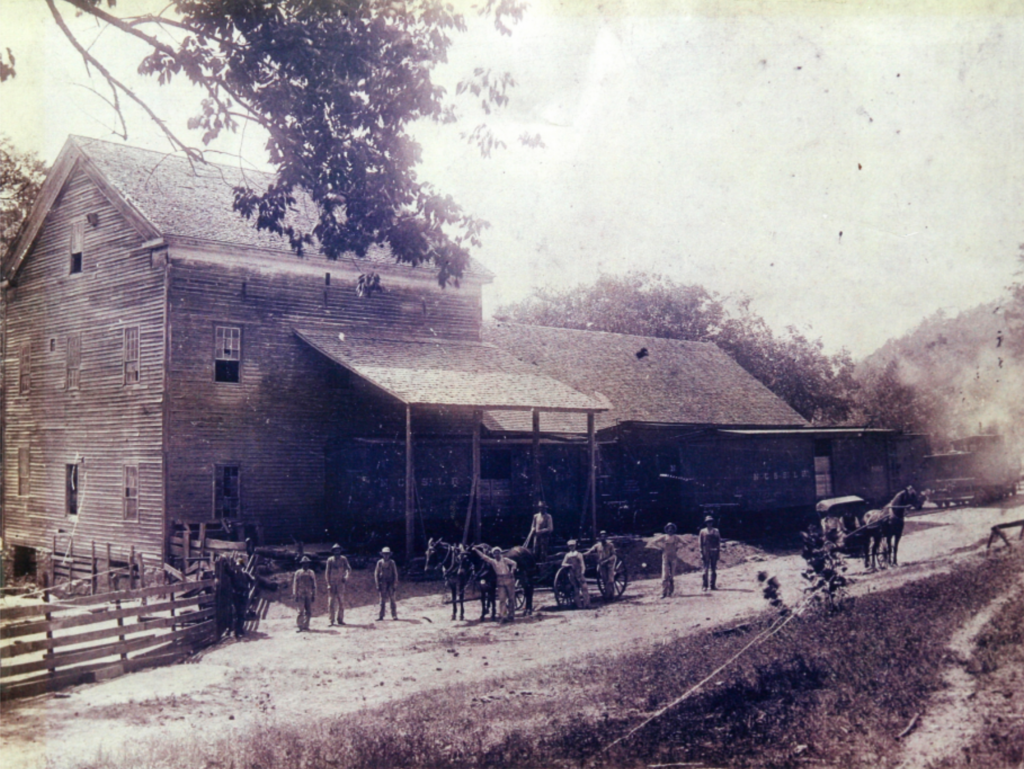
AKA Empire or Amelia Mill Note: The famed Civil War locomotive, Texas can be seen with tender in the far right of the image Photo taken May 1903 and courtesy of the McCoy family
At one time Bartow had a dozen or more water powered grist mills scattered across the county. However, none have been as muddled with an identity crisis as the Empire Mill. The life span of the Empire Mill (45+ years?) encountered multiple owners, partnerships, re-fittings, varied industrial roles, rail history, mineral rights, land sales, bankruptcy, legal entanglements, debts, suits, and road disputes. Also, it was the final workplace for the famed Civil War locomotive, The Texas.
Deeds found in the Bartow County Court House reveal the Empire Mill as having been in existence as early as December 15, 1862 and earlier (Book T, page 454). A purchase between Henry B. McConnell to William J. Williford, both of Bartow County transacted a sale for the mill located in the 4th District, 3rd Section on lot 1046 (mill lot) and included lots 1115, 1116 and 1186 containing 40 acres. The sales price was $11,750.00 ($450,700.00 in 2024) The deed mentions the original survey was conducted when the county was part of Cherokee County and originally contained 220 acres.
The mill was located on the Pumpkinvine Creek about two miles southwest of Emerson. However, the more prominent community at the time was the old mining site of Bartow, one mile south of Emerson. Emerson was originally known as Stegall Station, later incorporated in 1888, but had a post office and depot in 1875. Bartow was an active mining community of two dozen homes, 1000 acres, commissary, post office/rail stop for the Western and Atlantic, and mining furnace operated by the Tennessee Coal and Mining Company. (An 1864 map refers to the site as Allatoona Iron Works.)
On December 20, 1862, William Williford sells half ($6,750.00) of his interest in the Empire Mill and associated land lots to Howard Erwin. On October 12, 1868, William Williford and Howard Erwin along with other parties sell the Empire Mill and associated tract of land to William Milner for the sum of $10,000.00.
As a side bar, on May 7, 1869, Book Y, pages 728, 729 indicate William T. Wofford (former Bartow Confederate General who fought at Gettysburg) and W. H. Pritchard established a warranty bond on several outstanding financial obligations owed by Henry B. McConnell on the previous 1862 Empire Mill sale. The consolidation was an effort to resolve a convoluted debt history among several parties regarding outstanding obligations owed to a number of people including: Mr. W. L. Witherspoon, John Clayton, Hardy Strickland, George M. Gill, Joshua R. Parrott, W. L. Cothran, and The Bank of South Carolina. The combined debts amounted to approximately $4000.00 (Approximately $151,000.00 in 2024). Wofford and Pritchard placed a lien on the property arranging an agreement to exempt the current mill owners (A. W. Mitchell, W. J. Williford, John J. Howard, and John J. Erwin) of any personal obligations.
On May 2, 1880, William Milner sells the Empire Mill and associated properties to C. M. Jones for the amount of $4500.00. However, the arrangement appears to exclude the water wheel, turbine and piping. The deed concludes that Williford, Howard, Erwin, and Mitchell provide a warranted title to support the sale to C. M. Jones.
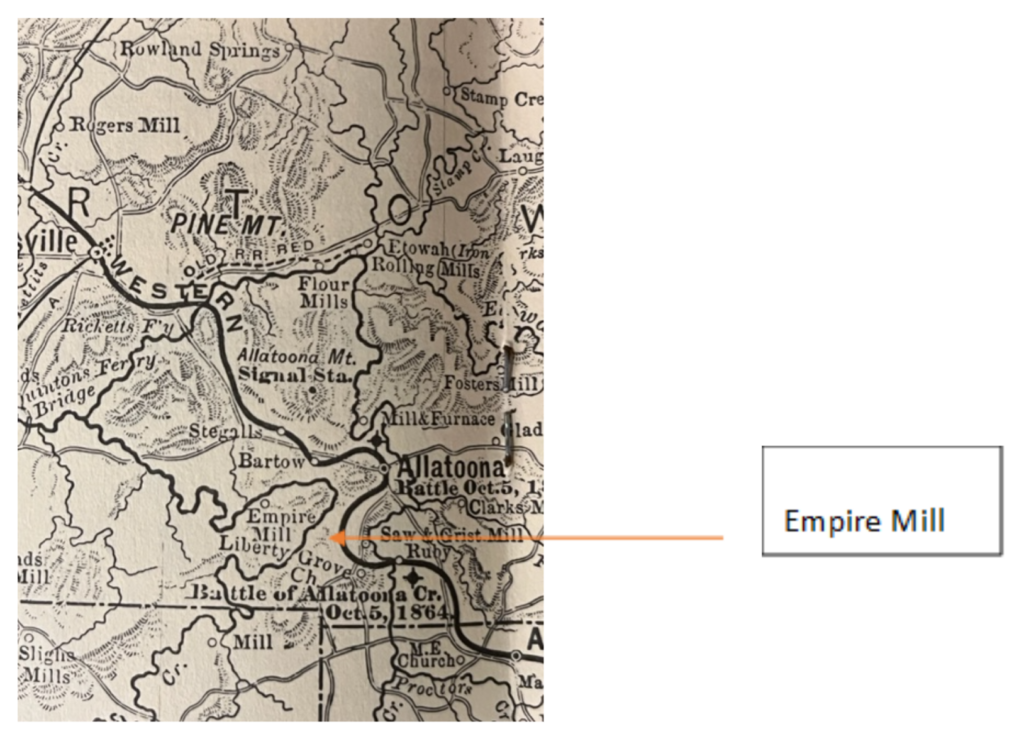
Map of Army Operations
Atlanta Campaign
Kingston to Atlanta
Joseph Brown
An 1881 article appearing in the Free Press discretely announcing that a “woolen factory is being erected of no small pretentions.” In October of 1881, the Free Press follows up with a more formal announcement that C. M. Jones, Morris and Earnshaw “have set looms in motion and have driven another spike in Bartow enterprises.”
In April 1881 The Cartersville Express printed an article entitled, “They want the Road Open” that revealed Emzy Stegall closed a road that directly impacted C. M. Jones and the Empire Mill operations. The article reveals the road belonged to the Bartow Iron Works and leased to Emzy Stegall. Mr. Stegall responded that the action was in compliance of the road owners located in New York, but the paper learned that hard feelings had risen between Jones and Stegall resulting in this matter. The article continues that these are two of the finest men in the county, standing in the church, and call upon Col. Bates to look into the Pumpkinvine settlement and resolve the issue, continuing to say, “the men of such standing should set a better example and not quarrel.” The dispute was heard before the Ordinary April 21 and resulted in a judgement that the obstacle be removed.
On April 9, 1886, Book Z, p 511, J. E. Morris sells his interest in the Empire Mill property to C. M. Jones for $3000.00. The sale included 220 acres and the mill, but excluded the water wheel, pump and piping.
An 1895 document was recorded in the County Court House (Book FF, pages 652 and 653) describing a transaction between C. M. Jones and David P. Morris for half interest in several land lots including lot 1046 in the amount of $600.00. It appears this deal may have been for mineral or mining rights. (The mill was listed as a boundary reference.)
In a related transaction, it is noted in March of 1898, deed book HH page 317, C. M. Jones sells a tract of land to A. J. Smith for $387.50 involving lots: 968, 977, 976, 975, 1040, 1041, 1042 and 1043 with a provision that Smith could use the railroad between Emerson and the Plaster Company. The indenture included an agreement that C.M. Jones would cooperate in making a public road from Emerson running by Empire Mill to Allatoona. This documentation adds evidence that a road and railroad spur to the mill was underway by the late 1800’s.

Photo courtesy of Atlanta Georgian and News August 2, 1907
According to the Atlanta Georgian and News and the North Georgia Citizen, the old Dixie Flyer engine 212, Texas (originally named the Cincinnati) had served its final years at the Amelia Mills in Emerson, but was destined to the junk heap. There it became exhausted and too aged to pull even light loads. As a result, it was abandoned on a siding left to the weeds and weather. Several newspapers ran stories advocating that the old Civil War engine be spared from the scrap pile. The Banks County Journal announced in 1911 that the Texas would be saved and removed to Fort Walker for a temporary storage and then to Grant Park for display in 1927. The Atlanta Constitution printed a robust story in 1912 about the role the Texas played in the Great Locomotive Chase and serving out its final days at a corn Mill in Emerson. The article continues with the plans that are in place to rally support to further salvage and restore the engine for placement at the new Cyclorama for all to see (Following its tenure at the Grant Park Cyclorama the Texas was reconditioned and relocated to the Atlanta History Center in 2017).
By May of 1899 it appears C. M. Jones and D. P. Morris had consummated a partnership for the Empire Woolen and Flouring Mill and expanded operations to include wool processing. Apparently, efforts to expand the mill had fallen into financial distress, and a disagreement surfaced between the two men reaching the Bartow Superior Court for resolution. Morris claimed he held a 12-month contract, was entitled to a specified salary, half of the grain or bushels of meal and expenses for travel to Atlanta to purchase equipment and gain experience about mill operations. The minutes of the Bartow Superior Court presented a detailed report and decision by Judge A. W. Fite of the case illustrating a comparison of operating costs expended by both the plaintiff and defendant who were seeking financial relief. The court recommended that the property be advertised twice in the Chattanooga Times and Atlanta Constitution. As a result, the court ordered they sell the property to the highest bidder on the courthouse steps by A. M. Foute, County Commissioner. (Book II, pages 222 & 223 which specifically lists, among others, lot 1046 where the mill was physically located) The highest bidder was A. J. Smith, in the amount of $1325.00. The sale was posted with the notice of all Sheriff’s sales as published in the local newspaper. The sale was structured with a one third down payment and the remaining two thirds to be paid over six and twelve months at a 7% interest rate. Once the final third of the payment was made, the title was transferred to the County Commissioner and then the title was transferred to Mr. A. J. Smith.
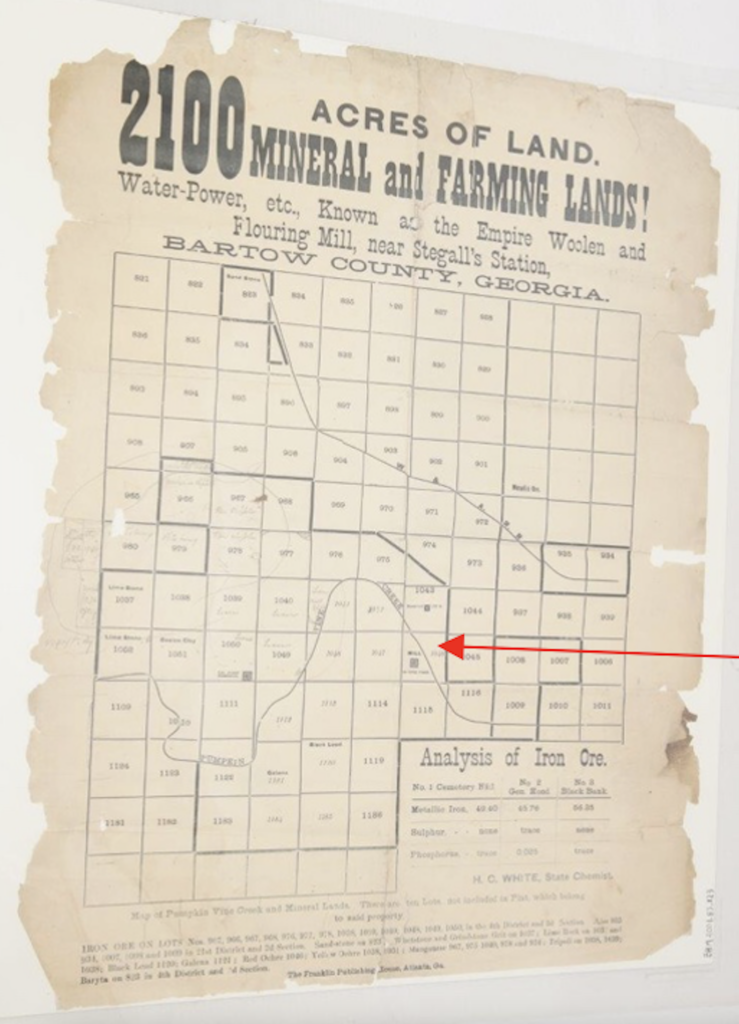
Map Courtesy of Bartow History Museum
During the time that A. J. Smith owned the mill, Smith renamed the Empire Mill as the Amelia Mill. He and his family were listed in the 1900 US Census as living in Atlanta and his occupation was recorded as “Milling Business”. Mr. Smith recruited the services of a Mr. Pendley from Morgan County to run the mill. A recent discovery of a 1957 journal kept by Pendley’s daughter, Jimmie Pendley Crossley (Ancestor to present day Lamar Pendley of Pendley Heating and Air Conditioning, Inc) was uncovered by local historian David Archer and shared with this author. According to her journal, the Pendley family arrived to the mill in 1899 from south Georgia and were amazed with the mountains, size of the mill and Pumkinvine Creek Dam.
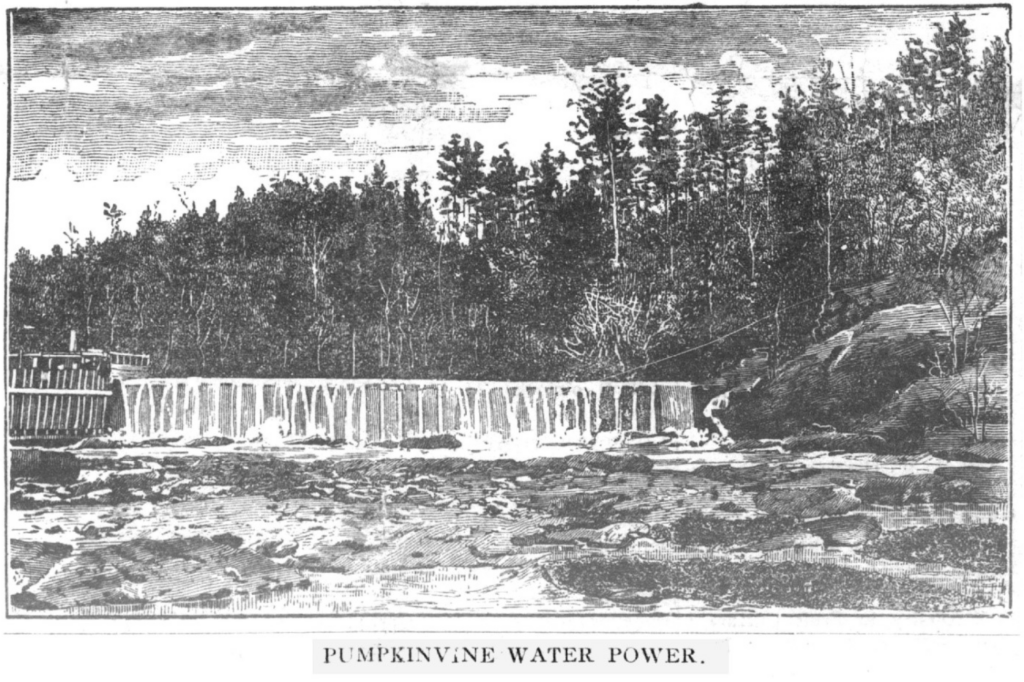
Her journal states that the mill was situated in a southwest direction about two miles from Emerson. She describes the mill as a two-story structure with the lower floor used for the grinding and upper floor had various hoppers, belts and pulleys. An elevator lifted grain to the hoppers where it fed down into the mills. The mill was operated by turbines and a race came from the dam to bring water to turn them. The race was about twelve feet high and level with the floor. The lower end of the mill had a long room called the “factory room” that had been used earlier for some textile work. She mentions that at the rear of this room was the race that fed water (to turbines) and then joined the creek where a deep hole existed and where she learned to swim. According to Jimmie, Jeff named the mill in honor of his daughter, Amelia. She mentions that in 1901 Jeff had the rail bed run further to reach the mill.
They found lodging across from the mill and a short distance up the creek near the dam. She describes the dam was built into a rock boulder with other rocks rising sharply about 10 feet above the water, but below the dam. Jeff provided them with some basics for their house including a cow, chickens, feed, firewood, furniture, and all the meal they wanted. She states that the mill RR line did away with the teams (horses or mules) and Jeff rented the famed Civil War locomotive Texas, which they just called, #212. She also remarks of riding the train on many occasions and that the engine did not have a cow catcher. At that time the Texas was still among the rolling stock leased by the Nashville, Chattanooga, and St. Louis (NC&StL) rail company. The rail right of way and rolling stock was owned by the State of Georgia (Western and Atlanta Railroad).
She writes, early one morning that her Pa went to start up the mill before breakfast and they heard a terrible explosion noise at the mill. They ran down to see what had happened and found her Pa rattled and speechless. They found on the floor one of the mill stones had burst slinging one half of the stone across the room and knocking off his hat and just barely escaping a fatal accident. She also describes at night they were often awakened by large logs or trees washing down the creek and colliding with the dam like thunder. There, the logs were stranded until they could turn down stream and go over the top of the dam.
She mentions that during the summers, Jeff (A. J.) Smith would bring his family to the mill where they would camp out in the “factory room.” He installed a stove, furniture, cooking supplies, vessels, and kept a buggy at the mill. He hung curtains to partition off sleeping quarters. She regarded Mr. Kontz as the “real” owner of the mill and felt he was a fine man. Eventually, Jimmie met a young man from the Allatoona area, Eugene Pendley, who did some handy work around the mill, and they later married. Eugene became a full employee of the mill and learned to run the Texas and loved to blow the whistle. Eventually, they moved away from the mill.
On May 31, 1900, an article was published in the Currant American newspaper referencing the recent death of Major General French who commanded Confederate forces at the Battle of Allatoona on October 5, 1864. Prior to his death French made a brief train trip to Marietta with his son and daughter. There he looked north, recalled the Battle of Allatoona and wept. The paper followed with a brief story of Lt. J. R. Henry, Company C 35 Mississippi whom locals believe to be the body buried in the Unknown Hero’s grave in the Allatoona Pass. The account cites that he marched with Sears Brigade to the battle ground passing what is now Amelia Mill (formerly Empire Mill).
The News and Courant of Cartersville mentions in the April 17, 1902, edition that Mr. A. J. Smith of the Amelia Mills is having his railroad repaired in first class order after being “thrown out of shape” by the high waters of the past winter.
An article ran in the Macon Telegraph on May 14, 1903 that a request for an injunction against the Tennessee Coal and Iron Company was previously filed by the Amelia Milling and Mining Company, but was dissolved by Judge Don A. Pardes. The restraining order was secured by the plaintiff Amelia Milling and Mining Company to prevent a pumping station to be erected in Bartow County. In the same month, an article ran in the Courant American that Col. Jones narrowly escaped a serious injury. He had met his son at the morning train and they drove out to the Emerson Mining ore washer to check on property and operations. When he re-entered the buggy the horse was restless and sharply turned the buggy unexpectedly hitting a gully and throwing Jones out head first. According to Dr. Monroe, Jones suffered a severe collar bone injury.
According to a notice published in the Cartersville News the Amelia Mill faced bankruptcy in 1905. By order of the United States District Court for the northern district of Georgia the Amelia Mill will be exposed for public sale at the Bartow County Court House door. The notice included an impressive list of the mill’s prior uses (grain, wool, flour, mineral rights) and operations regarding rail access, equipment, waterpower rights, horsepower water force, divided property parcels associated with real estate by lots, measures, and acreage. It specifically alludes to the land lot the mill is located as the first lot listed in the notice (1046) A. L. Kontz of Atlanta was named as the Bankruptcy Trustee. (As mentioned in the Jimmie Crossley journal, the mill was cited in several deeds as having been renamed the Amelia Mill. Mr. Kontz lived with the family of A. J. Smith for 20 years in Atlanta. Mr. Smith purchased the mill about 1900 and was very fond of the Kontz family.) According to transactions in the Bartow County Deeds Office, Book LL, pages 635-636 the highest bid was Robert F. Maddox transacted in January 24, 1905 on behalf of the Amelia Milling Company for $12,800.00. A follow up transaction on April 12, 1905 transferred the property from Maddox to the Amelia Mill Company.
In November of 1905 the Cartersville News announced that Col. C. M. Jones of Emerson purchased the Amelia Mill on the Pumpkinvine. The notice describes a splendid operation consisting of waterpower, corn, and wheat with about 600 acres. The article declares the mill has a capacity of twelve hundred bushels per day. Col. Jones states that the mill was owned by parties in Atlanta who did not push the milling operation and failed to give it attention. Col. Jones is organizing a stock company to push the milling business. According to an indenture on file in the Bartow Deeds Office (Book KK, Pages 725-733), Jones assembled a Board of Directors and entered into a complex bond agreement with the Atlanta Trust Company under the name of the Amelia Milling Company. The amount requested was $15,000.00 to finance and upgrade the mill. The terms specified the bonds to be issued in $1000 increments and backed by gold coin. The Trust Company specified that the mill be insured to protect the mortgage. (This venture places Col. Jones as a repeat owner.)
Also, deeds were filed to release sections of a dirt road serving the Amelia Mill owned by C. M. Jones to Bartow County. (Recorded in 1903, Book KK, page 472 and 1908, Book KK, Page 472)
While not fully clear, a subsequent transaction for mineral rights (Book SS, page 313) on February 12, 1906 is recorded between C. M. Jones and his son Virgil Jones for properties associated with the mill and the mill lot itself (1046). This transfer is followed by a transaction on October 8, 1906 (Book MM, page 473 and 474) between the “Amelia Mills Corporation” to G. B. Holder, W. B Hamby, and Jake C. Moore in the amount of $7500.00. The description of the sale references, “what was formerly known as Empire Woolen and Flouring Mills, afterwards the Amelia Mills”.
Subsequent deeds to the above were found in the Bartow County Court House that C. M. Jones sold his property including lot 1046 (mill site) to his son Virgil Jones. Two sales were recorded in 1906 (Book SS, Pages 312 and 313) February 12 and November 26 involving the mill and associated land lots.
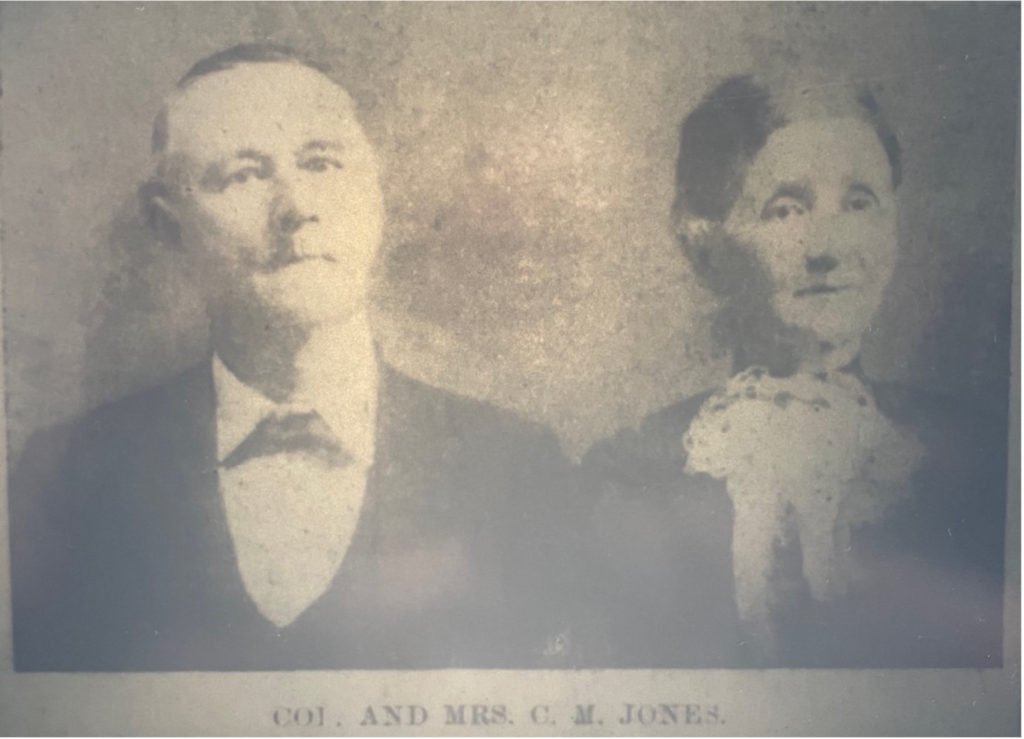
February 3, 1905 the Cartersville News reported C. M. Jones and wife Sarah Carroll Jones celebrated their 50th wedding anniversary. The article noted Col. Jones’ accomplishments, family and mentions that Sarah’s grandfather was a signer of the Declaration of Independence.
According to an October 1918 article in the Cartersville News, the Nashville and Chattanooga Railroad (NC&St.L.RR) applied to the Georgia Railroad Authority to discontinue service at its Emerson branch of spurs and sidings. This action would divest approximately 1.8 miles of track leading off the main line of the Western and Atlantic. The application was considered on November 7 and refused on the evidence of mining needs at several locations, and farmer’s dependance in the Pumpkinvine Creek area.
In 1918, the Bartow Tribune reported that while plowing property behind the old mill once belonging to the Williford Mill and later C. M. Jones 2 men struck upon a sixty-year-old casket of ancient make and design. The discovery was uncovered by John Russel and E. Y. McCoy. Judging from the size of the casket they assumed it was the remains of a 12- or 14-year-old. The paper requested anyone in the area who may know about the burial to please claim the remains. The casket was replaced where found.
According to Mr. Murl McCoy, grandson of Ensley McCoy (mill employee) and one of the last to pilot the Texas, the mill burned between 1905 – 1906. Local history holds that the Amelia Mill was accidently destroyed by fire. One theory is that the old Texas parked by the mill was fired up for work one morning and a spark from the smokestack ignited some nearby corn husks and silks. Following exhaustive research of available newspapers, this author could not find any documentation regarding a date or story of the mill fire.
The 1906 sale cited earlier may hint that the mill no longer existed during the sale to G. B. Holder, W. B Hamby and Jake C. Moore. So, we are left with oral history regarding the final days of the mill, a trail of documentation that chronicles the saga of the storied mill site, and a final sale to three gentleman who may or may not have purchased the actual mill with the property.
Acknowledgements and Interviews
This article could not have come about without the expertise of four gentleman listed below. Each are highly respected local historians, researchers, and presenters. This author is deeply indebted to their contributions to make this work a reality.
Sam Graham – Local Researcher and Historian
David Archer – Local Historian (Jimmie Crossley Pendley Journal)
Bill Popham – Emerson Historian, Interview 6/17/2024
Murl McCoy – Descendant of Ensley McCoy, interview 6/17/2024
Bibliography
Field Trip 2024
On March 12, 2024 a party of local historians along with guests from the Atlanta History Center visited the site of the Empire (Amelia) mill. The objective was to assist the Atlanta History Center personnel to more fully understand where the Texas served its final days. Among the party were: Murl McCoy, Bill Popham, David Archer, Joe Head, Hal Raper, Judd Smith, Ted Porter, Doug Biddy, and Kenny Darnell
Deeds
Bartow County Deeds Office, December 15, 1962, Book T, page 455
Bartow County Deeds Office, December 20, 1862, Book P, page 727
Bartow County Deeds Office, April 9, 1886, Book Z, page 511
Bartow County Deeds Office, October 12, 1868, Book Q, pages 734 and 735
Bartow County Deeds Office, May 7, 1869, Book Y, pages 727 – 729
Bartow County Deeds Office, May 2, 1880, Book V, pages 688 and 689
Bartow County Deeds Office, April 9, 1886, Book Z, p 511
Bartow County Deeds Office, February 20, 1888, Book Z, page 511
Bartow County Deeds Office, April ? 1895, Book FF, pages 652 & 653 (recorded Dec. 23)
Bartow County Deeds Office, December 3, 1895, Book FF page 615
Bartow County Deeds Office, March 5, 1898, Book HH page 317 (RR to Emerson)
Bartow County Deeds Office March 7, 1898, Bartow County Minutes, page 318 (Fonte to Smith)
Bartow County Superior Court Minutes, January 28, 1898, P, 95 – 100 C M Jones vs D. P Morris
Bartow County Deeds Office, May 26, 1899, Book II, page 222 and 223
Bartow County Deeds Office, May 17, 1900, Book KK, Page 472
Bartow County Deeds Office, October 8, 1903, Book KK, Page 653
Bartow County Deeds Office, January 1, 1904, Book KK, Pages 725 -733
Bartow County Deeds Office, January 24, 1905, Book LL, Pages 635 – 636
Bartow County Deeds Office, April 12, 1905, Book LL, Page 665
Bartow County Deeds Office, February 12, 1906, Book SS, Page 313
Bartow County Deeds Office, October 8, 1906, MM, Book Page 473
Bartow County Deeds Office, May 14, 1908, Book KK, Page 472
Bartow County Deeds Office, November 16, 1909, Book PP, Pages 422, 423
Bartow County Deeds Office, September 1910, Book PP, Page 422
Newspapers, Books and Articles
Cartersville Express, April 14, 1881, They want the Road Open
Cartersville Express, April 21, 1881, The Obstructions Shall be Removed
Emerson Newspaper, 1890’s, Pumpkinvine Water Power Dam
Free Express, October 10, 1881, The Empire Woolen Mills
The Cartersville Express January 29, 1884, The Empire Woolen and Flouring Mill
The Cartersville American, March 11, 1884, It is Rumored
The Courant – American, February 24, 1888, Great Gorges of Graphite
The Courant – American, August 8, 1899, Allatoona
The Courant – American, May 31, 1900, All Around in Bartow
The Courant – American, April 17, 1902, Throughout the County
The Courant – American, May 1903, Col. Jones Hurt
The Macon Telegraph, May 14, 1903, Dissolved the Injunction
The Cartersville News, February 16, 1905, Notice
The Cartersville News, February 23, 1905 Col. & Mrs. C. M. Jones
The Cartersville News, November 2, 1905, Fine Mill Property
The Atlanta Georgian and News, August 2, 1907, The Texas Saved Our Armies
The North Georgia Citizen, August 22, 1907, W&A Would Sell “Old Texas” for Junk
The Atlanta Georgian and News, November 23, 1907, Bequeaths a Home to Little Girls
The Atlanta Georgian and News, November 28, 1907, Young Heiresses to Family Home
The Atlanta Constitution, February 27, 1910, Remarkable Reunion Held by Jones Family
The Banks County Journal, May 11, 1911, “New Home for the “Texas”
The Atlanta Constitution, April, 1912, True Account on Andrews Raid and Role of “Texas”
The Bartow Tribune, August 1, 1918, Casket Found
The Cartersville News, October 31, 1918, Notice
The Bartow Tribune, November 14, 1918, The Emerson Branch to Remain
NC&StL Preservation Society, Summer 2018, Memories of a Beloved Locomotive, David Itbata
History of Bartow County, 1933, Lucy Cunyus
Census
United States 1900 Census, Georgia, Fulton County, Atlanta, Sheet 26, A. J. Smith
Local Resources
Etowah Valley Historical Society, Website
Bartow History Museum Archives
